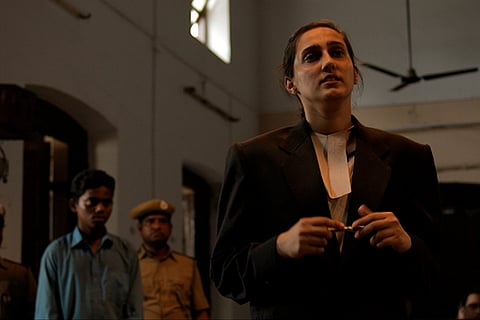

There’s a certain peace in the air that’s almost too good to last when Kosa, the Hindi film directed by Mohit Priyadarshi, begins. The calmness of a house in a village by the forest, the casualness of a sleepy morning for the young girl of the house, the older boy leaving, exchanging glances with the neighbour girl, goats in the yard, quiet pathways between the houses. Even if you have read nothing about the critically acclaimed Kosa, you know there’s trouble coming. And when it does, you can’t go back to the comfortable thought that it’s cinema, it’s unreal. Kosa is a fictionalised version of a real life story where an Adivasi boy is taken into custody by the local police in a case of mistaken identity.
At its screening at the International Film Festival of Kerala (IFFK), Mohit Priyadarshi stood before the audience with his young actors – Kunal Bhange who played the title character of Kosa, Kareena Jagat who played Kosa’s younger sister and Mona Waghmare the neighbour. “It was during a programme at my college that I heard about the real story from a human rights lawyer, Isha. It happened to a boy called Arjun. I met his father. We just plunged into the story and started filming without thinking of a possible release. We just wanted to tell the story,” Mohit said at the end of the rousing reception that the film received.
In the movie, Kosa Muchaki, a teenager in Class X, is accused of having a naxalite connection. On a day he goes to sell his father’s goat – that sunny sleepy morning we spoke of – policemen nab him in broad daylight, push him into the back of a jeep and start assaulting him. You have seen the boy’s home, a hut that can be broken down by bare hands. All his father could do is run to the nearby police station and ask for mercy. The Sub Inspector Raja (Sunil Chipde) feigns ignorance, and rebukes the man when he insists on filing a missing case.
A local journalist Keshav (Vitthal Kale), who has been helping out in such cases of innocent children being taken by the police, comes to the station, but SI Raja has only scorn for him. He gets the help of advocate Saira (Nooryab Nakhat), who has also been involved in these cases before.
Their fight to prove the boy’s innocence weighs down your heart, seeing the indifference of those that can make it right for him. The apathy is all too real.
“This situation has been there for a long time. What’s shown in the film has been happening to the Adivasi people for long. Now that it is coming to the cities and academic places where people are termed ‘urban naxals’ and arrested, more people are taking note of it,” Mohit tells TNM in an interview.
Davis (editor), Kunal, Mohit, Mona, Kareena
Arjun’s story happened in 2015-16. It was worse than its fictionalised version, Mohit says. “There is no legal procedure, no word of law and there are all kinds of legal loopholes.”
Kosa in the film is 16 or 17 years old, his father Sangram can’t be too sure. But the police were looking for a man of the same name who is 30 years old.
“We have been invading their (tribal people’s) space, arresting many innocent people by fabricating charges. Not just Adivasi people. Local journalists too have been incarcerated on fake charges. The character of Keshav is based on Santosh Yadav who was arrested on fabricated charges. There is no evidence in these cases and they are ultimately released. The idea is to create fear. An activist like Sudha (Sudha Bharadwaj who has been arrested in connection with the Bhima Koregaon case), if you keep in jail for 10 years, it could silence them. No one else would want to do what they have been doing – mobilising people, working on the ground, getting the news out,” Mohit says.
He ran into Sudha while shooting his film. The shooting itself had its risks. They avoided Chhattisgarh since that might bring even more trouble to the Adivasi people than what they were already going through. They chose a spot on the Madhya Pradesh-Chhattisgarh border.
For his debut film, Mohit chose non-film actors and tribal people, apart from a few who studied with him in college – the Film and Television Institute of Pune.
A lot of the crew are also from the FTII.
Kareena, who hails from a tribal community, spoke about how she’s seen similar happenings in her village. Mona too hails from one and said that the Adivasi community would be happy to watch this film. Kunal, who is from Bilaspur-Raipur, hadn’t known about these incidents before and used to tease classmates who hailed from Bastar (where Adivasis form the dominant group), he said. “But one must realise how such ideas (of prejudice) come to children. This film should be shown in Bastar, Chattigargh and in places like Delhi,” he said.